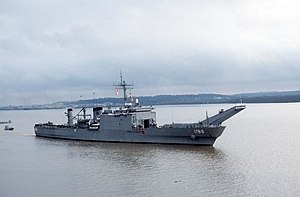 USS Saginaw in 1987
| |
| History | |
|---|---|
| Name | Saginaw |
| Namesake | Saginaw River |
| Ordered | 15 July 1966 |
| Builder | National Steel and Shipbuilding Company, San Diego, California |
| Laid down | 24 May 1969 |
| Launched | 7 February 1970 |
| Sponsored by | Wife of R. James Harvey |
| Commissioned | 23 January 1971 |
| Decommissioned | 28 June 1994 |
| Stricken | 28 June 1994 |
| Identification | LST-1188 |
| Fate | Sold to Royal Australian Navy as HMAS Kanimbla |
| Name | Kanimbla |
| Namesake | Kanimbla Valley |
| Acquired | 1994 |
| Commissioned | 29 August 1994 |
| Decommissioned | 25 November 2011 |
| Identification | L 51 |
| Fate | Sold for scrap, 20 May 2013 |
| General characteristics as built | |
| Class and type | Newport-class tank landing ship |
| Displacement | |
| Length | |
| Beam | 69 ft 6 in (21.2 m) |
| Draft | 17 ft 6 in (5.3 m) max |
| Propulsion |
|
| Speed | 22 knots (41 km/h; 25 mph) max |
| Range | 2,500 nmi (4,600 km; 2,900 mi) at 14 knots (26 km/h; 16 mph) |
| Troops | 431 max |
| Complement | 213 |
| Sensors and processing systems |
|
| Armament | 2 × twin 3"/50 caliber guns |
| Aviation facilities | Helicopter deck |
USS Saginaw (LST-1188) was the tenth of the Newport-class tank landing ships of the United States Navy which replaced the traditional bow door-design tank landing ships (LSTs). The second ship of that name, Saginaw was named after the river in Michigan. The LST was constructed by National Steel and Shipbuilding Company of San Diego, California, launched in 1970 and commissioned in 1971. During service with the United States Navy, the ship took part in US efforts in the Lebanese civil war and the Gulf War. Saginaw was decommissioned on 28 June 1994 and was transferred to the Royal Australian Navy on 28 August that year.
Recommissioned as HMAS Kanimbla (L 51), the LST underwent a major refit removing its bow ramps and using a crane to load and unload the vessel. The ship was retired from Australian service in 2011 after being replaced by HMAS Choules. The ship was towed back to the United States and broken up for scrap at New Orleans, Louisiana in 2013.